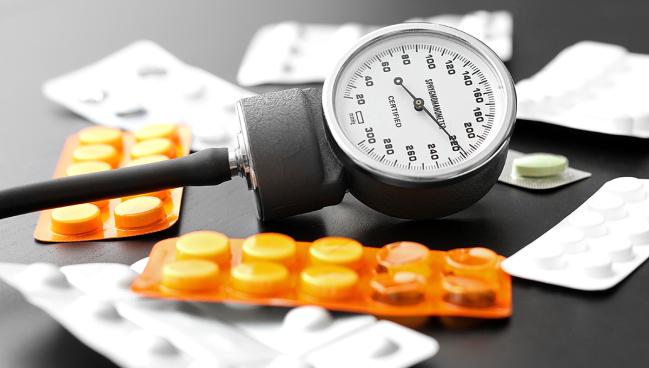Endothelin Receptor Antagonist Effective in Resistant Hypertension: PRECISION
Edema was seen in roughly 10% to 20% of patients, depending on the dose, but it was clinically manageable with diuretics.

CHICAGO, IL—Use of an investigational endothelin receptor antagonist in patients with resistant hypertension has a significant impact on both automated office and 24-ambulatory blood pressure when compared with placebo, results of the PRECISION trial show.
After 4 weeks of treatment with aprocitentan (Idorsia Pharmaceuticals), doses of 12.5 mg and 25 mg resulted in an approximate 4 mm Hg-reduction in office systolic blood pressure and a 5.0 mm Hg-reduction in 24-hour ambulatory systolic blood pressure, respectively, after adjusting for the change in placebo.
Markus Schlaich, MD (The University of Western Australia, Perth), who presented the results during the final late-breaking clinical trial session at the American Heart Association 2022 Scientific Sessions, said that “dual endothelin antagonism with aprocitentan may represent a new alternative pharmacological approach to treat resistant hypertension.”
The investigators, who published the study simultaneously in the Lancet, say that a 5-mm Hg reduction in office systolic blood pressure has previously been associated with an approximate 10% reduction in risk of major cardiovascular events, which is particularly relevant given the high risk of patients with resistant hypertension.
Resistant hypertension affects roughly 10% to 12% of patients with hypertension and is defined by the inability of three or more drugs—including a diuretic, a long-acting calcium channel blocker, and inhibitor of the renin-angiotensin-aldosterone system (RAAS)—to lower blood pressure to target. Schlaich said the endothelin pathway has been previously “implicated in the pathogenesis of hypertension,” particularly in sodium and water retention; the endothelin A and B receptors exert their effect through vasoconstriction and a range of other mechanisms, including increased stimulation of aldosterone secretion.
“The currently preferred fourth-line therapy for resistant hypertension is spironolactone based on the PATHWAY-2 study, which still targets the renin-angiotensin-aldosterone system, and I would argue that this leaves one very important system still unopposed, and that is the endothelin pathway,” said Schlaich. “Targeting the endothelin system, therefore, appears to be a very attractive target.”
A Truly High-Risk Population
Aprocitentan is not the first drug in this class to venture down this road. Bosentan (Tracleer; Actelion Pharmaceuticals), which is approved for the treatment of pulmonary arterial hypertension, and darusentan have both been tested in patients with uncontrolled or resistant hypertension and both have shown positive blood pressure-lowering effects. However, darusentan was abandoned 10 years ago after a confirmatory study failed to demonstrate a reduction in blood pressure and also showed it was associated with high rates of edema.
PRECISION was a multicenter, randomized, phase III study conducted in Europe, North America, Asia, and Australia in resistant hypertension patients (sitting systolic blood pressures 140 mg Hg or higher despite taking at least three antihypertensive medications). Schlaich said that more than 60% of patients were treated with at least four drugs at screening, more than 50% had diabetes mellitus, and 20% had a history of heart failure.
“So it was truly a high-risk population under investigation,” he said.
The study was conducted in three parts, the first being a 4-week study where 704 patients (mean age 62 years; 60% women) were randomized to aprocitentan 12.5 mg, aprocitentan 25 mg, or placebo. The second part of PRECISION involved treating all patients with aprocitentan 25 mg for 32 weeks. Finally, the third stage was a 12-week study in which patients were rerandomized to aprocitentan 25 mg or placebo.
There were 15.3- and 15.2-mm Hg reductions from baseline to week 4 in mean sitting office systolic blood pressure—the study’s primary endpoint—with the 12.5-mg and 25.0-mg doses, respectively. In the placebo arm, blood pressure was reduced by 11.5 mm Hg, translating into placebo-adjusted reductions of 3.8 and 3.7 mm Hg. The placebo-adjusted reductions in 24-hour ambulatory systolic blood pressure were 4.2 and 5.9 mm Hg, respectively. Schlaich noted that the reduction in 24-hour blood pressure was particularly pronounced at night, which may be relevant given its strong association with cardiovascular events.
In the longer-term phase, the reduction in office systolic blood pressure was sustained for the 32 weeks of the trial. When patients were re-randomized after part two of the study, blood pressure rose in patients randomized to placebo but was maintained in those patients who remained on aprocitentan. Similar results were observed with diastolic blood pressure. In patients with microalbuminuria and macroalbuminuria, as well as those with impaired kidney function, there were also significant reductions in systolic blood pressure.
Edema was the most commonly reported side effect during the initial 4-week double-blind part of PRECISION, occurring in 9.1% and 18.4% of patients treated with aprocitentan 12.5 and 25 mg, respectively. It was also observed in the single-blind, 32-week part of the trial and during re-randomization. However, study discontinuation resulting from fluid retention was rare, and roughly half of patients with edema were treated with an additional diuretic.
Suzanne Oparil, MD (University of Alabama at Birmingham), the discussant following the late-breaking presentation, said that while edema was seen in some patients, the adverse effect appears to be “clinically manageable.” She added that while it’s been known for some time that the endothelin pathway contributes to high blood pressure, there are as yet no available treatments. For her, the positive blood-pressure effects seen with the drug, along with its favorable side effect profile, represents a win for the investigational agent.
During the same-breaking clinical trials session, the BrigHTN investigators showed that baxdrostat (CinCor Pharma), an investigational inhibitor of aldosterone synthase, also successfully lowered blood pressure in patients with treatment-resistant hypertension, as reported by TCTMD. In PRECISION, the placebo-adjusted reduction in systolic blood pressure was smaller than the 11.0-mm Hg reduction seen in BrigHTN.
FRESH, a third drug trial in this same session also focused on resistant hypertension, tested firibastat (Quantum Genomics). Here, however, the investigational brain aminopeptidase A inhibitor failed to reduce systolic blood pressure versus placebo in patients already taking two to three other antihypertensive medications, and the company has announced it is dropping development of the drug for cardiology indications.
Any up-and-coming contenders would likely need to be tested against spironolactone, the currently recommended add-on therapy in patients with resistant hypertension.
Michael O’Riordan is the Managing Editor for TCTMD. He completed his undergraduate degrees at Queen’s University in Kingston, ON, and…
Read Full BioSources
Schlaich MP, Bellet M, Weber MA, et al. Dual endothelin antagonist aprocitentan for resistant hypertension: a multicenter, blinded, randomized, parallel-group, phase 3 trial. Lancet. 2022;Epub ahead of print.
Disclosures
- Schlaich reports institutional grants/contracts and personal consulting fees from Medtronic, Abbott Laboratories, and ReCor Medical; personal payment or honoraria from Medtronic, Abbott Laboratories, Merck, and Servier Laboratories; personal support for attending meetings, travel, or both from Medtronic and Abbott Laboratories.





Comments